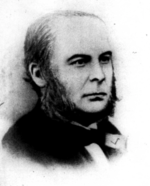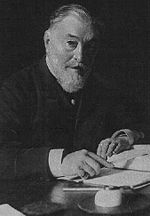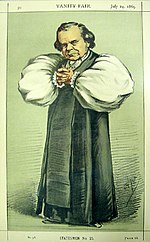Essays and Reviews (American Religious Thought of the 18th and 19th
Essays and Reviews , edited by John William Parker, published in March 1860,[one] is a wide-church book of 7 essays on Christianity. The topics covered the biblical enquiry of the German critics, the evidence for Christianity, religious thought in England, and the cosmology of Genesis.
Essays and Reviews was a popular book title in the 19th century: in that location are many similar books available, but none fabricated the same impact.
Background [edit]
Each essay was authored independently by 1 of six Church of England churchmen and one layman.[2] There was no overall editorial policy and each contributor chose his own theme. The half-dozen church building essayists were: Frederick Temple, who later became Archbishop of Canterbury; Rowland Williams, then tutor at Cambridge and later Professor and Vice-Principal of St David's University Higher, Lampeter; Baden Powell, clergyman and Professor of Geometry at Oxford; Henry Bristow Wilson, fellow of St John's Higher, Oxford; Mark Pattison, tutor at Lincoln Higher, Oxford; and Benjamin Jowett, Fellow of Balliol Higher, Oxford (later Principal) and Regius Professor of Greek, Oxford University. The layman was Charles Wycliffe Goodwin, former boyfriend of St Catharine's Higher, Cambridge, Egyptologist, barrister and, later, Assistant Gauge of the British Supreme Court for China and Nippon.
Significance [edit]
The volume was important considering of its date and its authors. Actualization 4 months after Charles Darwin's On the Origin of Species,[1] information technology summed up a three-quarter-century-long challenge to biblical history by the higher critics and to biblical prehistory by scientists working in the new fields of geology and biological science. Baden Powell restated his argument that God is a lawgiver, miracles break the lawful edicts issued at the creation, therefore conventionalities in miracles is atheistic, and wrote of "Mr Darwin'south masterly volume" that the Origin of Species "must presently bring about an entire revolution in stance in favour of the chiliad principle of the cocky-evolving powers of nature."[3]
"Outwardly, the disharmonize ended inconclusively, with the acquittal of Williams and Wilson by the courts and the condemnation of the volume past the clergy in Convocation. At a deeper level, it marked the exhaustion both of the Wide Church building and of Anglican orthodoxy and the first of an era of religious incertitude."[4]
Seven articles [edit]

- The Didactics of the World by Frederick Temple—"a warmed-over sermon urging the free study of the Bible"[5]
- Bunsen's Biblical Researches by Rowland Williams—"denying the predictive graphic symbol of Quondam Attestation prophecies"
- On the Study of the Evidences of Christianity by Baden Powell—"flatly denied the possibility of miracles"
- Séances Historiques de Genève. The National Church past Henry Bristow Wilson—"gave the widest possible latitude to the Thirty-nine Articles and questioned the eternity of damnation"
- On the Mosaic Cosmogony past C. Due west. Goodwin—"a critique of the attempted 'Harmonies' betwixt Genesis and geology"
- Tendencies of Religious Idea in England, 1688-1750 by Mark Pattison—"a learned and cold study of the evidential theologians of the eighteenth century"
- On the Interpretation of Scripture by Benjamin Jowett—"in which he urged that the Bible exist read 'similar any other book' and made an impassioned plea for freedom of scholarship"
"On the estimation of scripture" [edit]

The essay "On the interpretation of scripture" was contributed by Benjamin Jowett. When asked to contribute, Jowett saw the opportunity to challenge traditionalists.[6] He was a rationalist and insisted that the bible ought to exist treated every bit scholars treated classical texts. Jowett was a proponent of progressive revelation. The books of the Bible written after were seen to exist closer to the ultimate revelation of God as seen in Jesus Christ as revealed in the Gospels. The epistles and other New Attestation writings were seen to wait back.[six]
The implication of Jowett'due south essay (and his other writings) — that revelation was ongoing and that scripture was e'er subject area to reinterpretation as each generation encountered them — was the target of his traditionalist foes. Jowett felt he was being slandered for his honesty concerning his beliefs but he suffered no actual penalization other than an infamously low salary at Christ Church, Oxford. However, in 1863 Jowett was brought before the vice-chancellor's court for teaching contrary to the doctrines of the Church of England; the instance was somewhen dropped.[6]
Reception [edit]

Hardly known outside bookish theological circles today, Essays sold 22,000 copies in ii years, more than Origin sold in its starting time xx years. It sparked 5 years of increasingly polarized debate with books and pamphlets furiously contesting the issues.[iii]
A review by Frederic Harrison published in the Westminster Review in October 1860[7] had the probably undesired effect of stimulating the attack on the book.[8] Harrison saw the essays every bit neither religious nor rational which was a double accident to the seven who saw the essays as promoting rational religion.
In Jan 1861, an anonymous review was published in the Quarterly Review.[nine] The author was later revealed as Samuel Wilberforce, the Bishop of Oxford. The Quarterly review was followed up by a letter to The Times co-signed past the Archbishop of Canterbury and 25 bishops which threatened the theologians with the ecclesiastical courts. Darwin quoted a proverb: "A demote of bishops is the devil's blossom garden", and joined others including the eminent geologist Charles Lyell, and the mathematician and Queen's printer William Spottiswoode, in signing a counter-letter of the alphabet supporting Essays and Reviews for trying to "establish religious teachings on a firmer and broader foundation".[ten]
On the subject Lewis Carroll wrote, "Let E = Essays, and R = Reviews: and then the locus of (E + R), referred to multilinear coordinates, will be plant to exist a superficies (i.e., a locus possessing length and breadth, but no depth)."[ commendation needed ]
Repercussions [edit]

Despite this alignment of pro-development scientists and Unitarians with liberal churchmen, Williams and Wilson were charged with heresy in the Court of Arches. They were found guilty on some of the counts by the Dean of Arches, Stephen Lushington, simply appealed to the Judicial Commission of the Privy Council. The Judicial Committee comprised secular judges sitting with the Archbishop of Canterbury, the Archbishop of York and the Bishop of London. In 1864 information technology overturned the convictions, with the Archbishops of Canterbury and York dissenting in role (though the Bishop of London concurred in the decision). Information technology was said that the Privy Quango had "dismissed hell with costs". One hundred and thirty-seven thou laity signed a letter of thanks to the Archbishops of Canterbury and York for voting against the Commission, and a declaration in favour of biblical inspiration and eternal torments was fatigued up at Oxford and circulated to the 24,800 clergy, being signed past eleven thousand of them. Wilberforce went to the Convocation of Canterbury and in June obtained "synodical condemnation" of Essays and Reviews.[11]
Today the essay topics and conclusions may seem innocuous, simply at the time, the essays were described by their opponents as heretical, and the essayists were called "The Seven Against Christ."....[12]
Come across also [edit]
- Anglicanism
- Church of England
- Liberal Christianity
Notes [edit]
- ^ a b Browne 2002, p. 112.
- ^ Parker 1860.
- ^ a b Desmond & Moore 1991, p. 500.
- ^ Altholz 1982, pp. 186, 187.
- ^ This and the other summaries are taken from Altholz 1982, p. 186
- ^ a b c Hinchliff & Prest 2004.
- ^ Harrison 1860.
- ^ Ellis 1980, pp. 106–108.
- ^ Wilberforce 1861.
- ^ Desmond & Moore 1991, p. 501.
- ^ Desmond & Moore 1991, pp. 523–524.
- ^ Desmond & Moore 1991, pp. 500–501.
References [edit]
- Altholz, Josef Fifty. (1982). "The Mind of Victorian Orthodoxy: Responses to "Essays and Reviews", 1860-1864". Church History. 51: 186–197. doi:x.2307/3165835. JSTOR 3165835.
- Browne, Eastward. Janet (2002). Charles Darwin : The Power of Place. Princeton, Northward.J: Princeton University Printing. ISBN0-691-11439-0.
- Desmond, Adrian; Moore, James (1991). Darwin. London: Michael Joseph, Penguin Group. ISBN0-7181-3430-3.
- Ellis, Ieuan (1980). Seven Against Christ: A Study of 'Essays and Reviews' (Studies in the History of Christian Idea, No 23). Brill Bookish. ISBNninety-04-06200-9.
- Harrison, Frederic (1860). "Neo-Christianity". Westminster Review. J. Chapman. 18: 293–332. Published anonymously.
- Hinchliff, Peter; Prest, John (2004). "Jowett, Benjamin (1817–1893)". Oxford Dictionary of National Biography (online ed.). Oxford University Printing (published Sep 2004).
- Parker, John W., ed. (1860). Essays and Reviews. London: John Westward. Parker. Also available from Google-books.
- Wilberforce, Samuel (1861). "(Review of) Essays and Reviews". Quarterly Review. 109: 248–301. Published anonymously.
Farther reading [edit]
- Josef L. Altholz (1976). "The Warfare of Censor with Theology". The Mind and Art of Victorian England. University of Minnesota: VictorianWeb.org. Retrieved 2007-11-06 .
- Brock, West. H.; Macleod, R. Thou. (1976). "The Scientists' Announcement: Reflexions on Science and Belief in the Wake of "Essays and Reviews," 1864-five". The British Journal for the History of Scientific discipline. 9 (1 (Mar., 1976)): 39–66. doi:x.1017/S0007087400014485.
- Francis, Mark (December 1974). "The Origins of Essays and Reviews: An Estimation of Marking Pattison in the 1850s". The Historical Periodical. 17 (iv): 797–811. doi:10.1017/S0018246X00007913.
- Shea, Victor; Whitla, William (February 2001). Peter Ghosh (ed.). "Review: Essays and Reviews: The 1860 Text and Its Reading by". The English Historical Review. 116 (465): 149–151. doi:x.1093/ehr/116.465.149.
- Knight, Mark (2006). Nineteenth-century faith and literature: an introduction. Oxford [Oxfordshire]: Oxford University Press. ISBN0-19-927711-7.
- Nixon, Jude V. Nixon (2000). Victorian Religious Discourse: New Directions in Criticism. London: Palgrave Macmillan. ISBNone-4039-6522-6.
- Whitla, William; Shea, Victor (2000). Essays and reviews: the 1860 text and its reading. Charlottesville: University Press of Virginia. ISBN0-8139-1869-3.
- "Essays and Reviews". The Cambridge History of English and American Literature: An Encyclopedia in Eighteen Volumes. Bartleby.com. 1907. Retrieved 2007-eleven-06 .
- "Summary of Essays and Reviews". VictorianWeb.org.
Source: https://en.wikipedia.org/wiki/Essays_and_Reviews
0 Response to "Essays and Reviews (American Religious Thought of the 18th and 19th"
Post a Comment